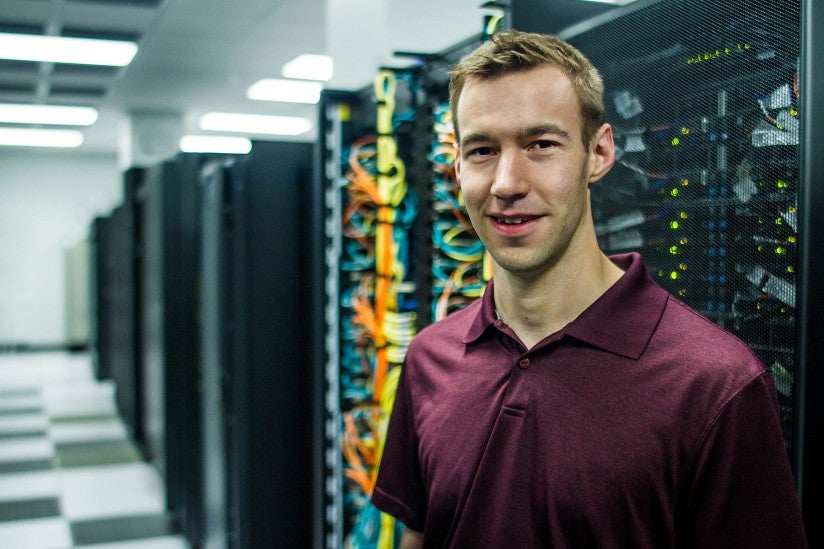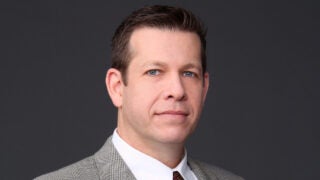Facebook fellow is inside the Internet every waking hour
USC Viterbi student works on issues that get between you and your destination while flooding the net with likes, selfies and those funny cat videos
The average Facebook user spends about 33 minutes per day on the social network. Multiply that by more than 150 million daily active users in the United States alone, and you get a Super Bowl audience every single day, flooding the net with likes, emoticons, selfies and cat videos, forming an algorithm that leads straight to Brandon Schlinker.
Schlinker is one of only 12, out of hundreds of international applicants, to be awarded a coveted Facebook Fellowship.
The third-year PhD student in the Department of Computer Science at the USC Viterbi School of Engineering works with Assistant Professor Ethan Katz-Bassett and the Networked Systems Lab to improve the Internet’s performance, reliability and security.
This means Schlinker is inside the matrix every waking hour. He’s the best friend you wish you had when the Internet bails on you.
“I figure out issues that get between you and your destination,” Schlinker said. “Anything that requires solving key Internet routing problems, like congestion and route hijacking.”
An aging protocol
Schlinker explained that outright failures and performance problems, like buffering in your videos, are often caused by the aging BGP protocol. BGP, or Border Gateway Protocol, is responsible for directing Internet traffic to the right gates. But BGP was built in 1994 and hasn’t changed much since. Those intimate with it marvel that it works as well as it does and doesn’t just bring the world to a halt.
Facebook must rely on this aging protocol to stream over 8 billion videos each day, including an emerging bandwidth beast — virtual reality.
Adding more madness, this year Facebook teamed with Turner Sports to present the first Virtual Reality live-stream of the NCAA Men’s Division I Basketball Championship, showcased by Facebook’s Oculus VR — which established its roots at one of USC’s innovation hubs, the Institute for Creative Technologies.
With a growing number of platforms competing for eyeballs, Facebook wants its user experience to be first-class. That’s why they recruit people like Schlinker to make sure challenges like BGP don’t stand in the way.
One of 12
To get an idea of how competitive landing a fellowship in Menlo Park can be, more than 200 researchers from the world’s top universities applied with outstanding proposals that addressed a specific Facebook challenge.
Only a dozen made the final cut.

“We receive applications from around the world across a broad spectrum of engineering and computer science disciplines,” said Rebekkah Hogan, Facebook’s research program manager. “We’re looking for emerging talent, no matter where they’re from and were very impressed not only by Brandon’s proposal, but also by his background and publication record.”
Facebook fellows receive two years of tuition, a living stipend and additional resources to advance their research. The real draw is that the fellowship blurs the line between research and engineering to solve problems, ultimately allowing new products to make the world more open and connected.
Overhaul the Internet?
If Schlinker could rebuild the Internet today, he’d do it differently.
“But I can’t just wake up one morning and say ‘I’m going to overhaul the Internet.’ Instead I have to focus on designing solutions that help users and content providers, but are also practical and deployable in today’s Internet.”
Many Internet problems have traditionally been difficult to tackle given the Internet’s decentralized structure, inherent barriers to adopting new technologies and cost constraints. However, Schlinker is certain that large content providers like Facebook are well positioned to leverage unconventional solutions.
That’s because these companies have built global networks with unprecedented connectivity to meet their users’ demands. As a result, they have many different routes they can use when sending traffic to end users — the individuals who use the product after it has been fully developed and marketed — and can often exchange traffic directly with an end user’s Internet service provider.
Working with good ideas
Schlinker, who also interned at Google last year, said he is indebted to his adviser, Ethan Katz-Bassett, and his colleagues at USC’s Networked Systems Lab.
“Ethan always challenges me to work on new ideas,” Schlinker said. “He also stresses that it’s not just about adding another publication to your resume. It’s about getting those ideas out into the industry.”
Brandon came to USC with an impressive set of relevant skills and experience.
Ethan Katz-Bassett
When Katz-Bassett equips students like Schlinker and sends them out to deploy solutions they’ve toiled over in his lab into the real world, he considers it “mission accomplished.”
“Brandon came to USC with an impressive set of relevant skills and experience. He works extremely hard, and he is very demanding of the quality of his work. I think one of the most important parts of a PhD program is learning how to pick problems. It is clear that the problems Brandon works on resonate with Facebook.”
The Network Systems Lab emphasizes picking relevant and real problems then empowering students to build systems that solve them.
“We collaborate widely with industry,” Katz-Bassett said. “This exposes our students to real problems and introduces them to opportunities like industry mentors, internships, access to data and pathways to deployment.”



